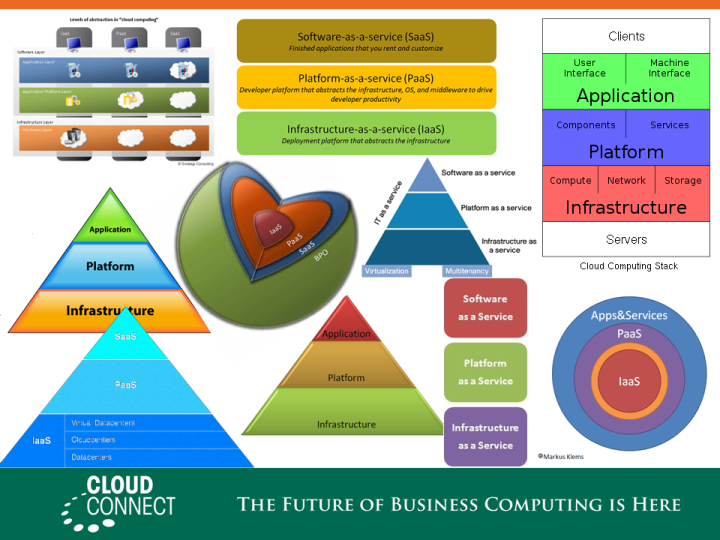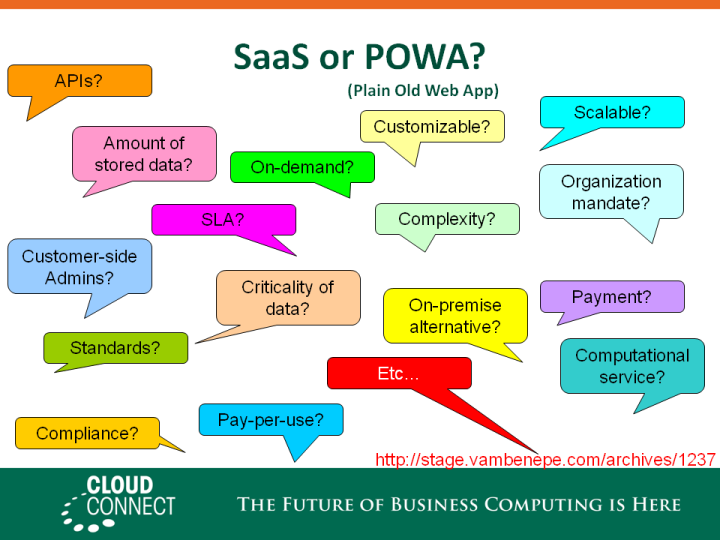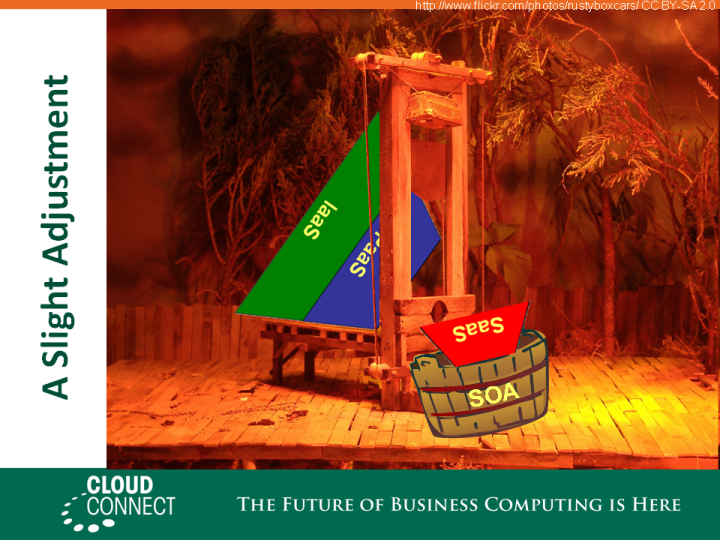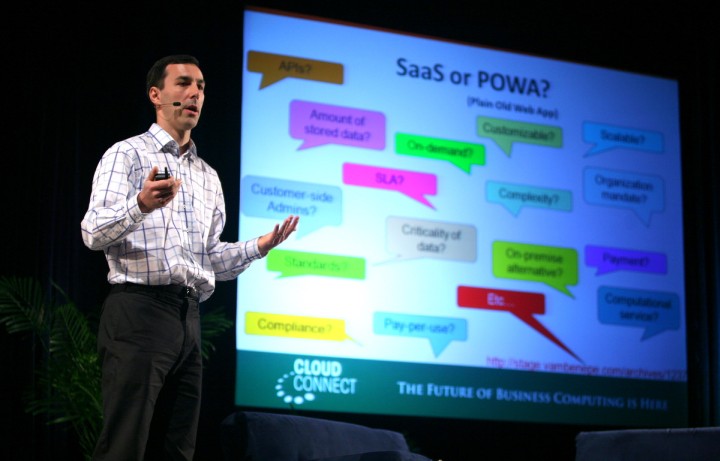I got invited to give a short keynote presentation during the Cloud Connect conference this week at the Santa Clara Convention Center (thanks Shlomo and Alistair). Here are the slides (as PPT and PDF). They are visual support for my bad jokes rather than a medium for the actual message. So here is an annotated version.
I used this first slide (a compilation of representations of the 3-layer Cloud stack) to poke some fun at this ubiquitous model of the Cloud architecture. Like all models, it’s neither true nor false. It’s just more or less useful to tackle a given task. While this 3-layer stack can be relevant in the context of discussing economic aspects of Cloud Computing (e.g. Opex vs. Capex in an on-demand world), it is useless and even misleading in the context of some more actionable topics for SaaS: chiefly, how you deliver such services, how you consume them and how you manage them.
In those contexts, you shouldn’t let yourself get too distracted by the “aaS” aspect of SaaS and focus on what it really is.
Which is… a web application (by which I include both HTML access for humans and programmatic access via APIs.). To illustrate this point, I summarized the content of this blog entry. No need to repeat it here. The bottom line is that any distinction between SaaS and POWA (Plain Old Web Applications) is at worst arbitrary and at best concerned with the business relationship between the provider and the consumer rather than technical aspects of the application.
Which means that for most technical aspect of how SaaS is delivered, consumed and managed, what you should care about is that you are dealing with a Web application, not a Cloud service. To illustrate this, I put up the…
… guillotine slide. Which is probably the only thing people will remember from the presentation, based on the ample feedback I got about it. It probably didn’t hurt that I also made fun of my country of origin (you can never go wrong making fun of France), saying that the guillotine was our preferred way of solving any problem and also the last reliable piece of technology invented in France (no customer has ever come back to complain). Plus, enough people in the audience seemed to share my lassitude with the 3-layer Cloud stack to find its beheading cathartic.
Come to think about it, there are more similarities. The guillotine is to the axe what Cloud Computing is to traditional IT. So I may use it again in Cloud presentations.
Of course this beheading is a bit excessive. There are some aspects for which the IaaS/PaaS/SaaS continuum makes sense, e.g. around security and compliance. In areas related to multi-tenancy and the delegation of control to a third party, etc. To the extent that these concerns can be addressed consistently across the Cloud stack they should be.
But focusing on these “Cloud” aspects of SaaS is missing the forest for the tree.
A large part of the Cloud value proposition is increased flexibility. At the infrastructure level, being able to provision a server in minutes rather than days or weeks, being able to turn one off and instantly stop paying for it, are huge gains in flexibility. It doesn’t work quite that way at the application level. You rarely have 500 new employees joining overnight who need to have their email and CRM accounts provisioned. This is not to minimize the difficulties of deploying and scaling individual applications (any improvement is welcome on this). But those difficulties are not what is crippling the ability of IT to respond to business needs.
Rather, at the application level, the true measure of flexibility is the control you maintain on your business processes and their orchestration across applications. How empowered (or scared) you are to change them (either because you want to, e.g. entering a new business, or because you have to, e.g. a new law). How well your enterprise architecture has been defined and implemented. How much visibility you have into the transactions going through your business applications.
It’s about dealing with composite applications, whether or not its components are on-premise or “in the Cloud”. Even applications like Salesforce.com see a large number of invocations from their APIs rather than their HTML front-end. Which means that there are some business applications calling them (either other SaaS, custom applications or packaged applications with an integration to Salesforce). Which means that the actual business transactions go across a composite system and have to be managed as such, independently of the deployment model of each participating application.
[Side note: One joke that fell completely flat was that it was unlikely that the invocations of Salesforce through the Web services APIs be the works of sales people telneting to port 80 and typing HTTP and SOAP headers. Maybe I spoke too quickly (as I often do), or the audience was less nerdy than I expected (though I recognized some high-ranking members of the nerd aristocracy). Or maybe they all got it but didn’t laugh because I forgot to take encryption into account?]
At this point I launched into a very short summary of the benefits of SOA governance/management, real user experience monitoring, BTM and application-centric IT management in general. Which is very succinctly summarized on the slide by the “SOA” label on the receiving bucket. I would have needed another 10 minutes to do this subject justice. Maybe at Cloud Connect 2011? Alistair?
This picture of me giving the presentation at Cloud Connect is the work of Alex Dunne.
The guillotine picture is the work of Rusty Boxcars who didn’t just take the photo but apparently built the model (yes it’s a small-size model, look closely). Here it is in its original, unedited, glory. My edited version is available under the same CC license to anyone who wants to grab it.




Pingback: William Vambenepe — Standards Disconnect at Cloud Connect
Pingback: Coté's People Over Process » Links for March 30th through March 31st
Pingback: Coté's People Over Process » Links for March 30th through March 31st
Pingback: William Vambenepe — The PaaS Lament: In the Cloud, application administrators should administrate applications
Pingback: William Vambenepe — Reading IBM’s proposed standard for Cloud Architecture
Pingback: » Will Clouds run on Clouds? Cloud Comedy, Cloud Tragedy